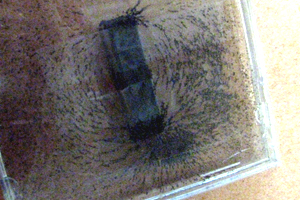 Iron filings reveal the pattern of a magnet's invisible force field.Saturday, March 20th, was not only Vernal Equinox, but the annual Sun-Earth Day: a NASA-promoted effort around the country to focus attention on the special connections between the Sun and the Earth. This year's theme: Magnetic Storms!
Iron filings reveal the pattern of a magnet's invisible force field.Saturday, March 20th, was not only Vernal Equinox, but the annual Sun-Earth Day: a NASA-promoted effort around the country to focus attention on the special connections between the Sun and the Earth. This year's theme: Magnetic Storms!
That gave me a lot to work with—Sun-Earth Day usually does, but the more opportunity to create hands-on experiences for our visitors, the better, and when it comes to curious natural phenomena, magnetism is a fertile subject for all sorts of seemingly magical fun.
So, I turned Chabot's Chemistry/Physics classroom into a public magnetism laboratory, giving visitors a chance to learn, or relearn, some of the basics of magnets, as well as to connect the tabletop experiments to phenomena that take place on enormous scales on the Sun and the Earth.
First was magnetic polarity: playing with a set of magnets, visitors got a feel for the behavior of magnetic poles—N and S—and how opposite poles attract and like poles repel. (It's always fun to feel the pull of attraction between two magnets, but there's something extraordinary about feeling the push of repulsion—your mind just expects to see little bumpers on the magnets, but there's seemingly nothing there!)
The Earth itself is a giant magnet, as most of us know—but what many of the adults found surprising and intriguing is the polarity of Earth's magnetic field. Using small magnetic compasses, we sought out the Earth's magnetic poles: north and south. By taking careful notice of which type of magnetic pole the compass needle ends pointed to, the fact that the magnetic pole of the Earth up near the geographic north pole is a south—or 'S'—magnetic pole was revealed! This is why in physics we are often careful to refer to magnetic poles as 'S' and 'N', not south and north, to avoid confusion.
